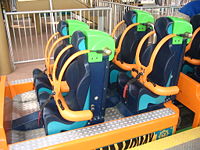
A movie theater, cinema, or cinema hall, also known as a movie house, picture house, picture theater or simply theater, is a business that contains auditoria for viewing films for public entertainment. Most are commercial operations catering to the general public, who attend by purchasing tickets.

An aisle is a linear space for walking with rows of non-walking spaces on both sides. Aisles with seating on both sides can be seen in airplanes, in buildings such as churches, cathedrals, synagogues, meeting halls, parliaments, courtrooms, theatres, and in long passenger vehicles. An aisle floor may be level or, as in theatres, sloping upward from a stage.

An auditorium is a room built to enable an audience to hear and watch performances. For movie theatres, the number of auditoria is expressed as the number of screens. Auditoria can be found in entertainment venues, community halls, and theaters, and may be used for rehearsal, presentation, performing arts productions, or as a learning space.

Bolliger & Mabillard, officially Bolliger & Mabillard Consulting Engineers, Inc. and often abbreviated B&M, is a roller coaster design consultancy based in Monthey, Switzerland. The company was founded in 1988 by engineers Walter Bolliger and Claude Mabillard, both of whom had worked for Giovanola.

A Floorless Coaster, commonly known as a Floorless Roller Coaster, is a type of steel roller coaster manufactured by Bolliger & Mabillard where riders sit with no floor underneath them, allowing their feet to swing freely just above the track. Development of the Floorless Coaster model began between 1995 and 1996 with Medusa at Six Flags Great Adventure opening on April 2, 1999, making it the world's first Floorless Roller Coaster. Floorless Roller Coasters also tend to have 3 to 7 inversions incorporated in the layout of the coaster.

In theatre and performing arts, the stage is a designated space for the performance of productions. The stage serves as a space for actors or performers and a focal point for the audience. As an architectural feature, the stage may consist of a platform or series of platforms. In some cases, these may be temporary or adjustable but in theaters and other buildings devoted to such productions, the stage is often a permanent feature.

A theater, or playhouse, is a structure where theatrical works, performing arts, and musical concerts are presented. The theater building serves to define the performance and audience spaces. The facility usually is organized to provide support areas for performers, the technical crew and the audience members, as well as the stage where the performance takes place.

A suspended roller coaster is a steel roller coaster model in which passengers are seated in open-top, boat-like gondolas that hang under the track. Traveling beneath the rolling stock, each gondola is affixed to a pivoting fulcrum or hinge assembly, allowing for the entire car to swing outwards and side-to-side as the train makes sharp turns along the course. Riders are typically secured with over-the-shoulder restraints. Due to the nature of the ride and the swinging effect, suspended roller coasters do not feature inversions, and are generally considered “family” rides; certain suspended roller coasters may be considered more or less intense than others, however.

A hypercoaster is a roller coaster with a height or drop measuring at least 200 feet (61 m). The term was first coined by Arrow Dynamics and Cedar Point in 1989 with the opening of the world's first hypercoaster, Magnum XL-200, which features a height of 205 feet. The next hypercoaster, Pepsi Max Big One, opened five years later at Blackpool Pleasure Beach featuring a height of 213 feet (65 m).

Alpengeist is an inverted roller coaster located at Busch Gardens Williamsburg in Williamsburg, Virginia. Manufactured by Bolliger & Mabillard, Alpengeist has an Alpine mountain region theme and opened in 1997 as the tallest inverted coaster in the world. The name "Alpengeist" is German for "Ghost of the Alps" or "Alpine Spirit", and the ride is themed to a runaway ski lift. It has the records for the tallest complete circuit inverted coaster in the world, tallest inverted roller coaster in the United States, and the longest complete circuit coaster drop in the world.

A music venue is any location used for a concert or musical performance. Music venues range in size and location, from a small coffeehouse for folk music shows, an outdoor bandshell or bandstand or a concert hall to an indoor sports stadium. Typically, different types of venues host different genres of music. Opera houses, bandshells, and concert halls host classical music performances, whereas public houses ("pubs"), nightclubs, and discothèques offer music in contemporary genres, such as rock, dance, country, and pop.

Busch Gardens Williamsburg is a 422-acre (1.71 km2) amusement park in James City County near Williamsburg, Virginia, United States, located approximately 60 miles (100 km) northwest of Virginia Beach. The park was developed by Anheuser-Busch (A-B) and is owned by United Parks & Resorts. The park opened on May 16, 1975, adjacent to Anheuser-Busch's brewery and near its other developments, including the Kingsmill Resort complex.

Griffon is a steel roller coaster located at Busch Gardens Williamsburg amusement park in James City County, Virginia, United States. Designed by Bolliger & Mabillard (B&M), the Dive Coaster model opened to the public on May 18, 2007. It climbs to a height of 205 feet (62 m) and reaches a maximum speed of 71 mph (114 km/h). It features two Immelmann loops, a splashdown, two vertical drops, and was the first B&M Dive Coaster to use floorless trains. Griffon was well-received by media and enthusiasts, and it placed third in 2007 in the category of Best New Ride polled by Amusement Today for their annual Golden Ticket Awards. Since its debut, it has also consistently ranked in the top 50 among steel roller coasters worldwide in the same annual publication, peaking at #19 in 2010.

The Dive Coaster is a steel roller coaster model developed and engineered by Bolliger & Mabillard. The design features one or more near-vertical drops that are approximately 90 degrees, which provide a moment of free-falling for passengers. The experience is enhanced by unique trains that seat up to ten riders per row, spanning only two or three rows total. Unlike traditional train design, this distinguishing aspect gives all passengers virtually the same experience throughout the course of the ride. Another defining characteristic of Dive Coasters is the holding brake at the top of the lift hill that holds the train momentarily right as it enters the first drop, suspending some passengers with a view looking straight down and releasing suddenly moments later.
There are different types of theatres, but they all have three major parts in common. Theatres are divided into two main sections, the house and the stage; there is also a backstage area in many theatres. The house is the seating area for guests watching a performance and the stage is where the actual performance is given. The backstage area is usually restricted to people who are producing or in the performance.

Pirates 4D was an attraction film designed to be shown in a specially-built or remodeled theater space in a theme park, featuring in-theater special effects, sometimes referred to as a 4D film.
In architecture, sightlines are a particularly important consideration in the design of civic structures, such as a stage, arena, or monument. They determine the configuration of such items as theater and stadium design, road junction layout and urban planning. In cities such as London, construction within sightlines is restricted to protect the key views of famous landmarks

SheiKra is a steel Dive Coaster roller coaster at the Busch Gardens Tampa Bay amusement park in Tampa, Florida, United States. The roller coaster was proposed by Mark Rose, vice-president of design and engineering for the park, and designed by Bolliger & Mabillard. The ride was planned to be 160 feet (49 m) high, but the park's executives rejected this and the height was changed to 200 feet (61 m). SheiKra reaches a maximum speed of 70 miles per hour (110 km/h) and has a total track length of 3,188 feet (972 m). It first opened on May 21, 2005, and was converted to a floorless roller coaster on June 16, 2007, following the opening of its sister Dive Coaster Griffon at Busch Gardens Williamsburg that year.

Pantheon is a steel roller coaster at Busch Gardens Williamsburg theme park in Williamsburg, Virginia. Manufactured by Intamin, the roller coaster opened to park members on March 4, 2022 and features four launches, five airtime hills, and a 95-degree beyond vertical drop. The 178-foot-tall ride (54 m) inverts riders twice and reaches a maximum speed of 73 mph (117 km/h). Its theme is set to ancient Rome with a focus on the ancient culture's deities Jupiter, Mercury, Minerva, Neptune and Pluto. Despite marketing for the ride, it has never held the fastest multi-launch coaster record. Soaring With Dragon held this record from September 2016 until May 2024 with Cedar Point opening Top Thrill 2.



















